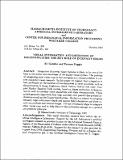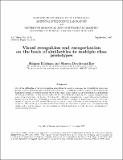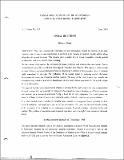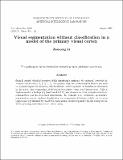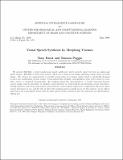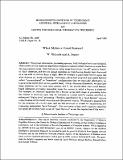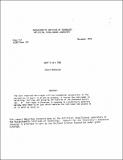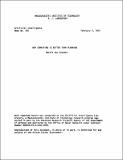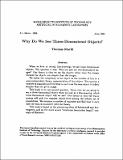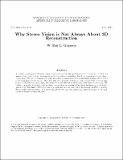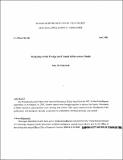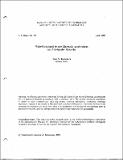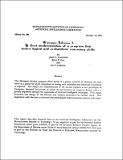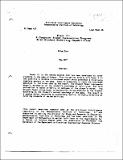Browsing AI Memos (1959 - 2004) by Title
Now showing items 1194-1213 of 1217
-
Visual Integration and Detection of Discontinuities: The Key Role of Intensity Edges
(1987-10-01)Integration of several vision modules is likely to be one of the keys to the power and robustness of the human visual system. The problem of integrating early vision cues is also emerging as a central problem in current ... -
Visual Position Extraction using Stereo Eye Systems with a Relative Rotational Motion Capability
(1973-03-01)This paper discusses the problem of context-free position estimation using a stereo vision system with moveable eyes. Exact and approximate equations are developed linking position to measureable quantities of the ... -
Visual Recognition and Categorization on the Basis of Similarities to Multiple Class Prototypes
(1997-09-01)To recognize a previously seen object, the visual system must overcome the variability in the object's appearance caused by factors such as illumination and pose. Developments in computer vision suggest that it may be ... -
Visual Routines
(1983-06-01)This paper examines the processing of visual information beyond the creation of the early representations. A fundamental requirement at this level is the capacity to establish visually abstract shape properties and ... -
Visual Segmentation without Classification in a Model of the Primary Visual Cortex
(1997-08-01)Stimuli outside classical receptive fields significantly influence the neurons' activities in primary visual cortex. We propose that such contextual influences are used to segment regions by detecting the breakdown of ... -
Visual Speech Synthesis by Morphing Visemes
(1999-05-01)We present MikeTalk, a text-to-audiovisual speech synthesizer which converts input text into an audiovisual speech stream. MikeTalk is built using visemes, which are a small set of images spanning a large range of mouth ... -
Visual Tracking
(1992-10-01)A typical robot vision scenario might involve a vehicle moving with an unknown 3D motion (translation and rotation) while taking intensity images of an arbitrary environment. This paper describes the theory and implementation ... -
What a Parallel Programming Language Has to Let You Say
(1984-09-01)We have implemented in simulation a prototype language for the Connection Machine called CL1. CL1 is an extrapolation of serial machine programming language technology: in CL1 one programs the individual processors ... -
What Are Plans For?
(1989-10-01)What plans are like depends on how they're used. We contrast two views of plan use. On the plan-as-program-view, plan use is the execution of an effective procedure. On the plan-as-communication view, plan use is like ... -
What Makes a Good Feature?
(1992-04-01)Using a Bayesian framework, we place bounds on just what features are worth computing if inferences about the world properties are to be made from image data. Previously others have proposed that useful features reflect ... -
What's in a Tune
(1974-11-01)The work reported here began with two fundamental assumptions: 1) The perception of music is an active process; it involves the individual in selecting, sorting, and grouping the features of the phenomena before her. ... -
Why Conniving is Better than Planning
(1972-02-01)A higher level language derives its great power form the fact that it tends to impose structure on the problem solving behavior for the user. Besides providing a library of useful subroutines with a uniform calling ... -
Why Conniving is Better than Plannng
(1972-04-01)This paper is a critique of a computer programming language, Carl Hewitts PLANNER, a formalism designed especially to cope with the problems that Artificial Intelligence encounters. It is our contention that the ... -
Why Do We See Three-dimensional Objects?
(1992-06-01)When we look at certain line-drawings, we see three-dimensional objects. The question is why; why not just see two-dimensional images? We theorize that we see objects rather than images because the objects we see are, ... -
Why Stereo Vision is Not Always About 3D Reconstruction
(1993-07-01)It is commonly assumed that the goal of stereovision is computing explicit 3D scene reconstructions. We show that very accurate camera calibration is needed to support this, and that such accurate calibration is difficult ... -
WIRElist
(1969-01-01)This memo describes a design aid used for the automatic production of wirelists for machine or hand wiring of wire-cards. -
Workshop on the Design and Control of Dextrous Hands
(1982-04-01)The Workshop for the Design and Control of Dexterous Hands was held at the MIT Artificial Intelligence Laboratory on November 5-6, 1981. Outside experts were brought together to discuss four topics: kinematics of hands, ... -
Wrist-Partitioned Inverse Kinematic Accelerations and Manipulator Dynamics
(1983-04-01)An efficient algorithm is presented for the calculation of the inverse kinematic accelerations for a 6 degree-of-freedom manipulator with a spherical wrist. The inverse kinematic calculation is shown to work synergistically ... -
Wumpus Advisor 1: A First Implementation Program that Tutors Logical and Probabilistic Reasoning Skills
(1976-10-01)The Wumpus Advisor program offers advice to a player involved in choosing the best move in a game for which competence in dealing with incomplete and uncertain knowledge is required. The design and implementation of ... -
Wusor II: A Computer Aided Instruction Program with Student Modelling Capabilities
(1977-05-01)Wusor II is the second program that has been developed to tutor students in the game of Wumpus. From the earlier efforts with Wusor I it was possible to produce a rule-based expert which processed a relatively complete ...

